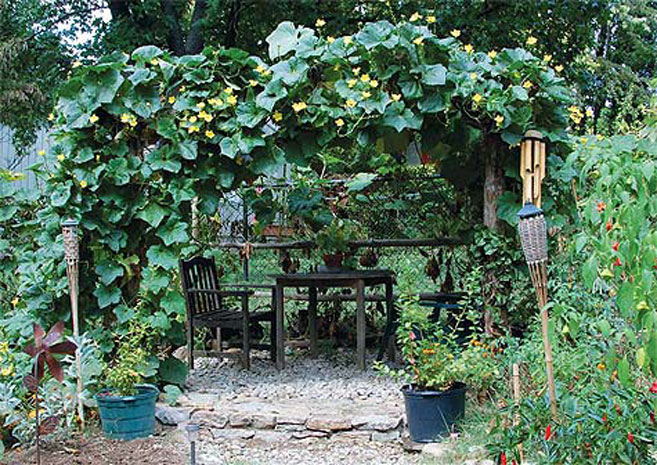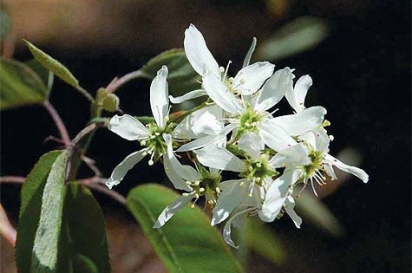Vegetables are the New Lawn
Have you noticed the epidemic? Vegetables and herbs are escaping from backyards and making their way into the side and even frontyards of homes throughout the city.
Vegetable gardening is not just for the backyard anymore. Edible landscaping is not a new concept, but is becoming more mainstream and popular. More and more people are starting to turn their landscapes and lawns over to edible plants. I am not talking about your grandmother’s garden with tidy rows of corn and beans. Instead, an edible landscape is designed much like a conventional landscape. Plants of varied form, color and foliage are arranged along with paths and sitting areas. The results are attractive as well as functional and provide flowers, food, medicine and more: therapy, beauty and sustenance all just outside your door.
Let’s consider the many reasons why edible landscaping makes sense. First, consider the environment. The average conventionally managed lawn produces more pollution than an equal area of agricultural land. Less lawn means less mowing, which equals less carbon emissions. With good composting practices there is no need for additional fertilizer, mitigating nutrient runoff into streams and lakes. When you use pesticides of any kind, organic or conventional, you kill beneficial insects as well. This disrupts the natural balance and often creates more pest problems in the long term. A diverse garden with many different species of plants and healthy soil is resistant to pests and supports the wildlife that controls pests without chemicals.
You may get some nibbling guest here and there but don’t run for the bug spray. The damage is generally cosmetic and rarely is a major threat. It’s better to have food with a few holes in it than covered with poisons. All this adds up to a healthier planet and a healthier environment for your family. Another consideration is food security. People are becoming more aware of the importance of local food and wanting to know about where their food comes from.
Growing your own food offers the ultimate peace of mind. Imagine strolling through the yard after work, picking your own vegetables and herbs to cook for dinner. It doesn’t get any more local than that. Maintaining your edible landscape is not much more work than maintaining a conventional one. As with any landscape, maintenance will depend on size. Adding some Swiss chard or colorful leaf lettuce to a border would add very little work to your normal routine. On the other hand converting your entire lawn and planting all edibles would be a considerable investment in time. But the work would be very rewarding and could supply a considerable amount of your food needs. I would rather pick vegetables than mow grass any day. Anyone apprehensive could simply plant a serviceberry tree. This is my number one favorite edible landscape plant — and most people don’t realize the tasty berries are edible! Commonly sold in garden centers as an ornamental, it is filled with white flowers in spring, edible berries in summer, nice yellow/orange fall leaf color and an interesting multi-trunk form in the winter. This tree is a four-season beauty. With a 15–20-foot mature height it’s perfect for most city lots.
Another easy idea to get started with is the luffa vine. Yes, this is the same luffa that bath sponges are made from. Luffa is an annual vine that will quickly cover a trellis and fill with attractive yellow flowers and large green leaves. A member of the cucumber family, when small the fruits are edible and when they mature and hollow out they can be peeled and cleaned to make your own sponges. The sponges are very durable and can be used for many types of cleaning. Another attribute of the luffa is that it attracts beneficial insects. It is a favorite of bees, which help to pollinate a lot of other plants as well. Once you’re on a roll you might find yourself ripping out the overgrown shrubs in the front yard and planting some blueberry bushes. Planted in acidified soil they are pretty carefree and gorgeous once established. After your first harvest of fresh berries I think you’ll find they were worth a little extra effort.
Whether you plan on starting small or taking out the whole lawn, it’s a good idea to have a plan. If you are new to gardening you might want to consult a professional designer who specializes in edible landscapes to help get you started. There are also many good books out on the subject. If you do decide to go large and do away with the grass, it’s better to start small and work in phases so you can get a feel for the amount of maintenance involved. Maybe start by planting some of your favorite cooking herbs or by replacing some annual flowers with some colorful leafy greens such as Swiss chard, lettuce or kale.
The important thing is to plant things you like and will use. That being said, vegetables planted and nurtured with your own hands always taste better. So don’t be afraid to try things you normally dislike. For example, canned peas are very dull and flavorless. But I still remember eating peas fresh from the pod when I had a garden as a child. They were wonderful; I almost didn’t believe it was the same vegetable. To this day I still won’t touch them from a can, but I wait with anticipation for those first pods to ripen in the garden so I can break them open and pop them in my mouth.
Getting kids involved with plants is another benefit of an edible landscape. They seem to eat more vegetables and try new things. Vega-phobic children will munch on cherry tomatoes and carrots directly from the garden all day long. Your edible landscape helps form a connection with nature and disconnect from the television and video games. Most kids are happy to help out in the garden. Give them their own space to tend and let them pick what they would like to plant. A purple carrot variety like Dragon is a great choice for kids to grow. Purple on the outside and orange on the inside they make a great colorful nutritious snack kids are sure to love.
I have covered just a few plants and ideas. There are many more for you to discover on your own or with the help of a specialist. It’s not hard for anyone to have a landscape that is both beautiful and bountiful. Go ahead, let your vegetables roam free throughout the landscape.
David Netherton is a landscaper in the Louisville area specializing in creating unique outdoor spaces. He can be reached at davidbnetherton@yahoo.com.






